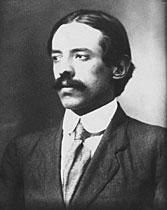
Alejandro Schulz Solari was born in San Fernando, Buenos Aires Province in 1887. After briefly studying architecture, in 1912 he undertook a trip to Europe, disembarking in London.
During his long stay in Europe, he lived in various towns - Paris, Turin, Genoa, Marseilles, Zoagli, Florence, Milan and Munich. In Italy, he became friends with Pettoruti who claimed that, at that time (1916), Xul had a perfect mastery of water-colours, a technique that together with tempera, dominates almost his entire production. At that time, he also had great knowledge of religions and hermetic philosophy.
He began to sign as Xul Solar and held his first exhibition in Milan in 1920 along with the sculptor, Arturo Martini. There he exhibited oils which followed the renovating currents of European art, mainly of Expressionism and Fauvism, but always keeping within a mystical spiritualism, materialised by an imaginative symbolism. He also exhibited water-colours influenced by a certain interpretation of the arabesque taken from Art Nouveau and geometric synthesis which were close to abstraction. In his paintings, he always kept a visionary approach, even in those works that relied more on conventions of figuration.
His quest for universal harmony induced him to work for the improvement of human communication. In this sense, he spent years creating languages such as the neo-Creole-a mixture of modified forms of Spanish and Portuguese- and a universal language called panlingua. These and other inventions such as the panjogo -a sort of extremely complex chess- a modified Tarot or the piano with textured and coloured keys corresponding to the different sounds, are related to the principles of astrology to which he devoted much of his life.
Around 1953, he worked on a series of water-colour projects and facades for houses on the Delta and, towards 1958, he worked on his "grafías plasti útiles" (plasti-useful graphics) with which he elaborated a system of plastic writing.
He held few exhibitions after returning to Argentina in 1924. This same year, he participated at the Salón Libre held at Galería Witcomb. In those days, he made friends with the intellectual avant-garde group that published Martín Fierro magazine, the staff of which he joined. He also started his friendship with writers Oliverio Girondo, Macedonio Fernández, and especially, with Jorge Luis Borges.
In 1929, he held his first solo exhibition in Buenos Aires at Amigos del Arte. In 1940, he carried out an exhibition in the same institution; in 1949 he exhibited at Galería Samos; in 1951, he showed his works at Galería Guión and in 1953 at Galería Van Riel. He took part in group exhibitions held at museums and art galleries. He died in Tigre, Buenos Aires Province in 1963. That same year, an exhibition introduced by Borges, was held as a tribute to him at the Museo Nacional de Bellas Artes. In 1990, his house in Buenos Aires was opened as a museum where a great part of his work is exhibited.